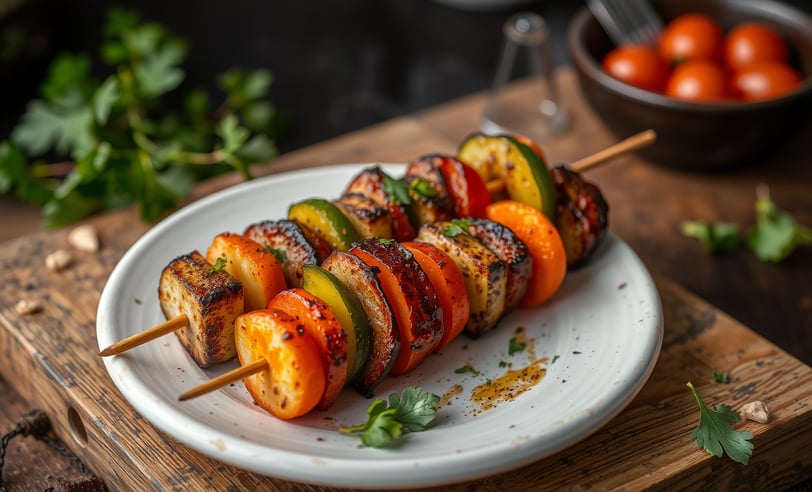The Ultimate Guide to Preparing Vegetable Kebabs
FOOD
10/18/20245 min read


Selecting the Right Vegetables
When preparing vegetable kebabs, the choice of vegetables plays a crucial role in enhancing both flavor and aesthetic appeal. Seasonal vegetables are often the best candidates, not only due to their peak freshness but also because they tend to offer richer flavors. For instance, summer brings a variety of options such as zucchini, bell peppers, and cherry tomatoes, which pair excellently with one another. The blend of colors—from the vibrant greens of zucchini to the deep reds and yellows of bell peppers—creates visually appealing kebabs that can entice even the most novice eaters.
Texture is another important consideration. Leafy or overly watery vegetables can become mushy when grilled, so it is advisable to opt for firmer vegetables like mushrooms, eggplants, and asparagus. These types not only hold up better on skewers but also develop complex flavors when charred. Evenness in cutting the vegetables is essential; uniform sizes ensure that they cook evenly, preventing some pieces from being undercooked while others may become overly charred.
In addition to choosing the right vegetables, freshness should not be overlooked. Selecting organic produce, when available, can offer a more robust flavor and may contain fewer pesticides. Look for vegetables that are tightly packed, with vibrant colors and no signs of wilting or bruising. When it comes to enhancing the taste of your vegetable skewers, marinades can make a significant difference. Different vegetables may benefit from unique seasoning combinations, so exploring various herbs and acidic components can create an array of flavorful options. Remember, the goal is to bring out the best in each vegetable, allowing them to shine through in the final dish.
Marinating Your Vegetables
Marinating vegetables before grilling is an essential step that significantly enhances their flavor profile. By immersing vegetables in a flavorful marinade, one can unlock a realm of taste that elevates the overall dish. A marinade typically consists of an emulsified mixture of oil, acid, and seasonings. Olive oil is a popular base due to its rich flavor and ability to coat the vegetables, while vinegars, such as balsamic, red wine, or apple cider, provide the necessary acidity.
When selecting herbs and spices for your marinade, consider traditional combinations like rosemary and garlic with potatoes or cumin and coriander with bell peppers. However, inventive mixtures can also yield delightful results; for example, a blend of honey, soy sauce, and sesame oil can introduce an unexpected Asian flair to your skewers. Fresh herbs like basil or cilantro can be added for brightness, while dried spices such as paprika or chili powder can introduce depth and heat.
The ideal marinating time can vary based on the type of vegetable. Tender vegetables like zucchini or cherry tomatoes typically require only 30 minutes to an hour of marination, whereas sturdier options, such as eggplant or mushrooms, can benefit from several hours or even overnight. This range allows the flavors to penetrate the vegetables effectively without compromising their texture. It is crucial to balance the marination period, as excessive time can lead to mushiness.
The science behind marination lies in the vegetables' ability to absorb flavors. The oil in the marinade acts as a solvent that carries the flavor compounds, while the acidity helps break down cell walls, ensuring a tender and flavorful result during grilling. Properly marinated vegetable kebabs not only complement the smoky flavor from the grill but also bring vibrant colors and textures to your plate. By following these guidelines, home cooks can achieve the perfect balance of taste and tenderness in their vegetable kebabs.
Skewering Techniques for Perfect Kebabs
Creating delightful vegetable kebabs requires careful attention to the skewering techniques employed. The choice of skewer can significantly influence the grilling process and the final outcome. Two main types of skewers are prevalent: metal and bamboo. Metal skewers are durable, reusable, and tend to conduct heat, aiding in cooking from the inside. Conversely, bamboo skewers are lightweight, cost-effective, and available in various lengths, but they require soaking in water for about 30 minutes prior to use. This soaking prevents the skewers from burning on the grill, ensuring that the focus remains on the vegetables being grilled.
When it comes to threading vegetables onto skewers, the order of placement is a key consideration. Different vegetables possess varying cooking times; thus, it is essential to select and arrange them in a manner that promotes even cooking. For instance, denser vegetables such as bell peppers and zucchini may require more time to become tender, while softer options like cherry tomatoes and mushrooms need less. A recommended approach is to start with the firmer options and intersperse them with the softer varieties, creating a visually appealing pattern while maintaining optimal cooking times.
Additionally, proper spacing between the vegetable pieces is paramount. Ensuring that there is sufficient air circulation around each piece allows for even grilling, preventing sogginess and enabling slight char to develop, which enhances flavor. This attention to detail is crucial for achieving perfectly grilled kebabs that boast both texture and taste.
Safety is also vital while handling skewers. Always use heat-resistant gloves when turning or arranging skewers on the grill. Employ long-handled tools for adjusting positions to avoid burns. By employing these skewering techniques—ranging from choosing the right type of skewer to correct vegetable placement and safety considerations—you can assemble enticing vegetable kebabs that are as delicious as they are visually appealing.
Grilling and Serving Suggestions
Grilling vegetable kebabs is a delightful way to enhance their natural flavors, offering a smoky char that complements the freshness of the ingredients. Various methods can be employed, including using a charcoal grill, a gas grill, or an oven, depending on personal preference and availability. For charcoal grilling, it is essential to allow the coals to reach an optimal temperature, which typically requires about 15-20 minutes of heating. The ideal temperature for grilling vegetable kebabs corresponds with direct medium heat, generally around 350°F to 400°F. On a gas grill, preheat the grill for about 10-15 minutes on medium heat, ensuring consistent cooking temperatures.
Cooking times for vegetable kebabs vary based on the type of vegetables used. Typically, a cooking duration of 10 to 15 minutes should suffice. It is advisable to turn the kebabs every few minutes to achieve an even char and prevent burning. Pay close attention to softer vegetables such as bell peppers, zucchini, or cherry tomatoes, as they tend to cook faster than denser options like mushrooms or eggplants. If using wooden skewers, ensuring they are soaked in water for at least 30 minutes prior to grilling will help prevent them from catching fire.
Serving suggestions abound when it comes to vegetable kebabs. They can be beautifully presented alongside dips such as tzatziki, romesco, or hummus. Complementing them with various sides—such as couscous, quinoa, or a fresh garden salad—will create a well-rounded meal. For gatherings, consider arranging the kebabs on a large platter for an appealing display that invites guests to serve themselves. Leftovers can be stored in an airtight container in the fridge for up to three days. When reheating, it is essential to do so gently, using a microwave or oven at a low temperature to preserve their tender texture and flavor.
Wellness
Explore beauty tips and holistic health insights
contact us
Balance
sapwans2005@gmail.com
© 2024. All rights reserved.
